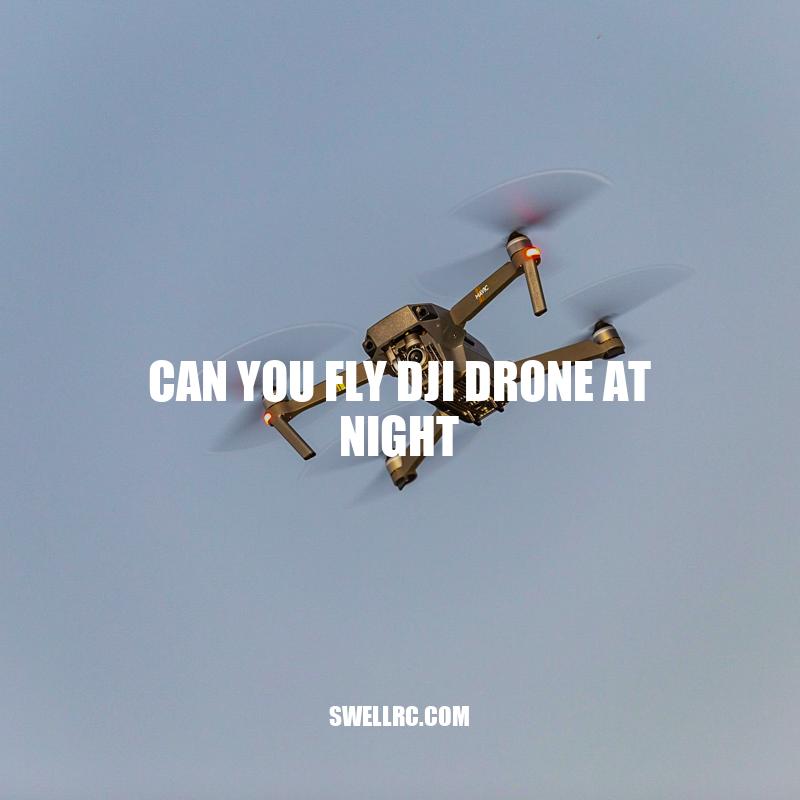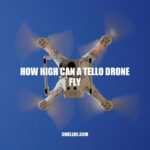Nighttime Flying with DJI Drones: FAA Regulations, Safety Tips, and Techniques
Drones have become increasingly popular for use in photography and videography. Their ability to capture stunning aerial footage has revolutionized the filmmaking industry and allowed for unique perspectives of landscapes, events, and even wildlife. However, there are rules and regulations in place to ensure the safety of the public and the pilot. The Federal Aviation Administration (FAA) has specific guidelines for drone usage that must be followed in order to legally operate a drone. One question that arises regarding drone usage is whether it is allowed to fly a DJI drone at night. While using drones during daylight hours (30 minutes before sunrise to 30 minutes after sunset) is allowed without additional permission, flying at night requires a special waiver from the FAA. In this article, we will explore the regulations, technology and safety considerations regarding flying DJI drones at night.
FAA Regulations
The FAA has regulations that need to be followed while flying the DJI drone at night.
- According to FAA regulations, drones are only allowed to be flown in daylight hours.
- A special waiver is required to fly a DJI drone at night.
- The pilot flying the DJI drone at night must have a Remote Pilot Certificate with a Small UAS Rating or be under the direct supervision of someone who has this certificate.
- The waiver request must be detailed, explaining why the nighttime flight is necessary and how the operation will be conducted safely.
- The FAA grants waivers on a case-by-case basis, and the process can take up to 90 days for approval.
It is important to note that flying a DJI drone at night without proper permission can lead to fines or legal action from the FAA.
What happens if you fly your drone at night?
- Flying a drone at night is dangerous and illegal in many countries.
- Pilots can lose sight of the drone in the dark, risking a crash or flyaway
- Drones can also be mistaken for UFOs or other aircraft, causing panic and potentially dangerous situations
- Fines and other legal consequences may be imposed on pilots who fly their drones at night without proper authorization
If you’re looking for safe and legal ways to fly your drone, check out reputable websites like the Federal Aviation Administration (FAA) or DJI for guidelines and resources.
DJI Drone Features
Despite FAA regulations for nighttime flying, DJI drones have advanced features that make flying at night safer and more efficient.
| DJI Drone | Nighttime Feature |
|---|---|
| Phantom 4 Pro | Camera with a 1-inch 20-megapixel sensor and mechanical shutter for crisp images, even in low-light conditions |
| Mavic 2 Pro | Hasselblad camera with a 1-inch CMOS sensor and adjustable aperture for capturing high-quality images in low-light conditions |
| Inspire 2 | Dual-band spotlight that illuminates the area in front of the drone, providing better visibility and obstacle avoidance |
- Some DJI drones have an infrared sensor system that enables better obstacle avoidance in low-light flying conditions.
- The Mavic Air 2 and Mavic 2 Pro have a “Night Shot” feature that automatically adjusts camera settings for better nighttime video and photo capture.
- DJI drones have the ability to work with specialized lighting equipment designed for nighttime flights.
These advanced features make DJI drones an attractive option for nighttime photographers and filmmakers, and can allow for better safety and efficiency while flying at night.
Can you use DJI drone at night?
Yes, you can use DJI drones at night, but it’s important to keep in mind the following points:
- Ensure that your drone is equipped with lights to comply with regulations in your area.
- Use a high ISO setting and low shutter speed to capture clear and bright footage.
- Avoid flying in areas with low visibility or obstacles that may be difficult to see in the dark.
Additionally, DJI offers a variety of products and accessories that may enhance your nighttime drone experience, including the DJI Mavic 2 Enterprise Dual with thermal imaging capabilities and the DJI Goggles RE for a first-person view in low-light conditions.
Nighttime Photography and Videography
While there are additional risks associated with flying DJI drones at night, nighttime photography and videography can produce stunning and unique results.
- Nighttime drone footage is perfect for capturing cityscapes and unique nighttime events such as fireworks and festivals.
- The additional lighting required for night flying can create interesting and dynamic lighting effects on subjects.
- Nighttime flying can allow for reduced disturbance of wildlife and people during sensitive operations such as search and rescue missions.
To capture high-quality nighttime images and videos with a DJI drone, pilots should consider the following:
- Use a drone with low-light camera capabilities such as the Phantom 4 Pro or Mavic 2 Pro.
- Use additional lighting such as a spotlight on the drone or external lighting equipment to illuminate the subject.
- Plan flights carefully to ensure safety and avoid obstacles such as buildings and trees.
- Experiment with camera settings and post-production techniques to achieve desired results.
By taking the proper precautions and utilizing the advanced features of DJI drones, pilots can capture impressive nighttime footage while ensuring safety and adherence to FAA regulations.
What is the most appropriate type of photography to be used during night time?
Here are some types of photography that are ideal for night time:
- Long exposure photography – this allows more light to enter the camera and capture stunning images of fireworks, cityscapes, and star trails.
- Low light photography – this technique allows capturing images in low light conditions, making it ideal for cityscapes, street photography, and portraits taken at night.
- Flash photography – flash photography involves using a flash to illuminate the subject in the dark. It is most used in portrait photography and event photography.
These techniques can help you capture stunning images during the night. However, it is important to have the right equipment such as a tripod, fast lens, and an external flash to get the best results. Visit photography websites like B&H or Adorama for more information on the right photography equipment to use at night.
Risks and Safety
While nighttime drone photography and videography can produce stunning results, it is important to be aware of the additional risks associated with flying a drone at night.
- Reduced visibility can make it difficult to see obstacles such as buildings, trees, and power lines.
- Low-light environments may cause sensors to malfunction, leading to decreased accuracy in obstacle avoidance systems.
- Additional lighting may be needed to illuminate the drone and ensure visibility to others.
- Nighttime flights may be more easily heard, and may cause disturbance to nearby wildlife and people.
To minimize these risks, pilots should consider the following safety measures when flying DJI drones at night:
- Make sure the drone is equipped with additional lighting, such as a spotlight or external lighting equipment, to ensure visibility.
- Fly in areas with minimal obstacles and away from people and crowded places.
- Avoid flying near airports or other restricted airspace.
- Use proper batteries to ensure the drone has enough power to complete the flight safely.
By taking these precautions and being aware of the additional risks associated with flying a drone at night, pilots can ensure a safe and productive experience while adhering to FAA regulations.
Can Drones Take Videos at Night?
Yes, some drones are equipped with night vision cameras or infrared sensors that allow them to capture videos in low light conditions. However, the quality of the footage may vary depending on the drone’s specifications and settings. It’s essential to check the manufacturer’s website and user manual to see the drone’s low-light capabilities and recommended flying conditions. You can also find specialized websites and products that offer tips and tools for shooting night videos with drones.
Conclusion
In conclusion, flying DJI drones at night is possible with a waiver from the FAA, but it requires proper training, planning, and precautions. It is important to be aware of FAA regulations and obtain the necessary certifications before attempting to fly a drone at night. DJI drones have advanced features that can facilitate safe nighttime flying, but pilots should still exercise caution and follow safety guidelines to avoid accidents or damage to property.
By following these guidelines and obtaining the necessary training and certifications, pilots can safely and responsibly capture stunning photos and videos at night, while minimizing risks to people and property.



